Template string
``Back quote
var cyy={ name:"cyy", age:18, say:function(){ console.log('My name is'+this.name+',I am this year'+this.age+'year'); }, say2:function(){ console.log(`My name is`+this.name+`,I am this year`+this.age+`year`);//Template strings can replace single or double quotes }, say3:function(){ console.log(`My name is ${ this.name },I am this year ${ this.age }year`);//Can use ${}Alternative string splicing }, say4:function(){ console.log(`My name is ${ `Miss ${this.name}` },I am this year ${ this.age }year`);//${}Nested }, say5:function(){ console.log(`My name is ${ `Miss ${this.name.toUpperCase()}` },I am this year ${ this.age }year`);//${}You can use the string method } } cyy.say(); cyy.say2(); cyy.say3(); cyy.say4(); cyy.say5();
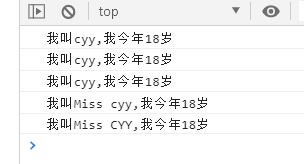
Render data in normal mode
//simulation ajax Get data function getList(){ //ajax return { status:true, msg:"Get success", data:[{ id:1, title:"title1", date:"date1" },{ id:2, title:"title2", date:"date2" },{ id:3, title:"title3", date:"date3" }] }; } //Structure assignment gets data (to data Alias listData) const {data:listData,msg,status}=getList(); if(status){ let arr=[]; //Cycle to get data listData.forEach(function({title,date}){ //Render data in normal mode arr.push('<li>\ <span>'+title+'</span>\ <span>'+date+'</span>\ </li>'); }) let ul=document.createElement("ul"); //join Array to string //arr.join('') String splicing //arr.join() Strings are separated by commas ul.innerHTML=arr.join(''); document.body.appendChild(ul); }else{ alert(msg); }
Render data using template strings (line wrapping is possible without escaping)
//simulation ajax Get data function getList(){ //ajax return { status:true, msg:"Get success", data:[{ id:1, title:"title1", date:"date1" },{ id:2, title:"title2", date:"date2" },{ id:3, title:"title3", date:"date3" }] }; } //Structure assignment gets data (to data Alias listData) const {data:listData,msg,status}=getList(); if(status){ let arr=[]; //Cycle to get data listData.forEach(function({title,date}){ //Template string rendering data arr.push(`<li> <span>${ title }</span> <span>${ date }</span> </li>`); }) let ul=document.createElement("ul"); //join Array to string //arr.join('') String splicing //arr.join() Strings are separated by commas ul.innerHTML=arr.join(''); document.body.appendChild(ul); }else{ alert(msg); }
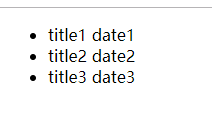
You can also further process the template string
//simulation ajax Get data function getList(){ //ajax return { status:true, msg:"Get success", data:[{ id:1, title:"title1", date:"date1" },{ id:2, title:"title2", date:"date2" },{ id:3, title:"title3", date:"date3" }] }; } //Structure assignment gets data (to data Alias listData) const {data:listData,msg,status}=getList(); function foo(str){ return str.replace("date","mydate"); } if(status){ let arr=[]; //Cycle to get data listData.forEach(function({title,date}){ //Template string rendering data arr.push(`<li> <span>${ `Course name ${ title }` }</span> <span>${ foo(date) }</span> </li>`); }) let ul=document.createElement("ul"); //join Array to string //arr.join('') String splicing //arr.join() Strings are separated by commas ul.innerHTML=arr.join(''); document.body.appendChild(ul); }else{ alert(msg); }
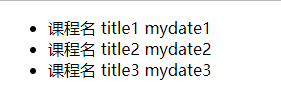
New method of string part
padStart padEnd completion string length
//padStart Complete from the front //The first parameter is the total length after completion, and the second parameter is the string used for completion let str="cyy"; let str2=str.padStart(8,"nice "); let str3=str.padStart(13,"nice ");
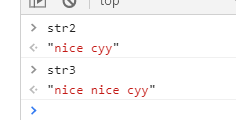
//padEnd Complete from the back //The first parameter is the total length after completion, and the second parameter is the string used for completion let str="cyy"; let str2=str.padEnd(8," nice"); let str3=str.padEnd(13," nice");
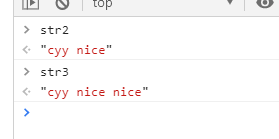
repeat string repetition
{ let str="c"; console.log(str.repeat(10));//Repeat 10 times. let str2="cyy "; console.log(str2.repeat(4));//Repeat 4 times. }

Note that repeat will report an error if a negative number less than - 1 is passed in, such as - 3
If a negative number greater than - 1 is passed in, such as - 0.33, it will turn to 0
If a decimal is passed in, such as 2.55, it will be rounded (round down, turn to 2)
Encapsulate functions to implement repeat like functions
{ console.log(myRepeat("s",10));//Repeat 10 times. function myRepeat(str,num){ // Define an array, the number of elements is num+1 // Then the array is converted to a string, and the str As separator return new Array(num+1).join(str); } }

startsWith endsWidth determines whether the string starts with and ends with
{ let str="i am cyy"; console.log(str.startsWith("i")); console.log(str.endsWith("yy")); }
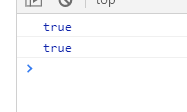
Include judgment exists
indexOf can also achieve similar functions
{ let str="i am cyy"; if(str.indexOf("cyy") !== -1){ console.log(`existence cyy`); } //~x=!(x+1) -1 It will turn to 0. if(~str.indexOf("cyy")){ console.log(`existence cyy`); } if(str.includes("cyy")){ console.log(`existence cyy`); } }
Traversal string before ES6
{ let str="i am cyy"; //Traversal in the original way for(var i=0,len=str.length;i<len;i++){ console.log(str[i]); //charAt Characters can also be returned by Subscripts console.log(str.charAt(i)); } }
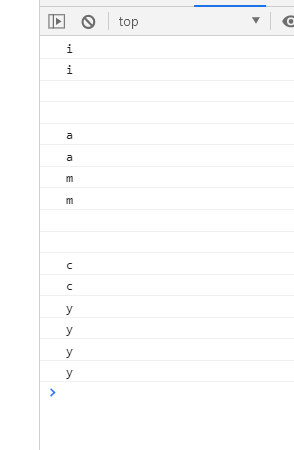
String to array, using slice of array prototype
{ let str="i am cyy"; //String to array let str2=Array.prototype.slice.call(str); console.log(str2); let str3=str.split(""); console.log(str3); //Extended operator let str4=[...str]; console.log(str4); //Extension operator 2 let [...str5]=str; console.log(str5); //Traversing array str5.forEach(function(w){ console.log(w); }) }
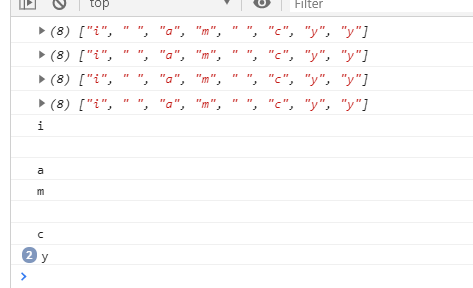
for in traverses the properties of an object or array
New for of ES6, only arrays can be traversed, not objects
forEach only traverses arrays, not objects
for traversal array common
Traversal operation string (using array mode)
Encrypt uppercase letters in strings
{ //Method 1 const map={ A:"100", B:"99", C:"98", D:"97", E:"96", F:"95", G:"94" }; const words="ABCDEFG"; let str="I AM CYY"; let ostr=[...str];//String to array ostr.forEach(function(word,index){ if(words.includes(word)){ ostr[index]=map[word]; } }) console.log(ostr); console.log(ostr.join(""));//Concatenate back string }

Traversing strings with for of
//for of Traversal string let str="I AM CYY"; for(let s of str){ console.log(s); }
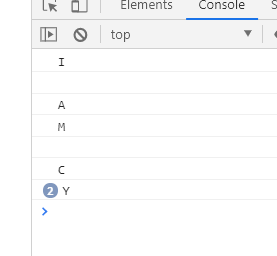
Using for of to realize data encryption
{ //for of Implement character encryption const map={ A:"100", B:"99", C:"98", D:"97", E:"96", F:"95", G:"94" }; const words="ABCDEFG"; let str="I AM CYY"; let nstr=""; for(let s of str){ if(words.includes(s)){ nstr+=map[s]; }else{ nstr+=s; } } console.log(nstr); }

unicode notation
{ //unicode Code point \u //Generally only recognize 0000-ffff //Because it can recognize four bits,\u1f43 yesὃ,Follow 6 let str="\u1f436"; console.log(str); //ES6 It is allowed to put curly brackets on code points, so that all code points will be identified and will not be truncated in four digits let str2="\u{1f436}"; console.log(str2); }

Remember to put quotation marks on the console input test
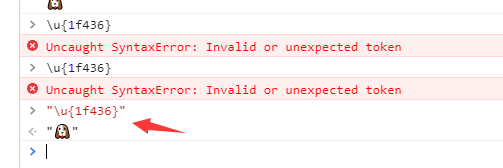
codePointAt gets the code point corresponding to a character in the string
{ //unicode Code point \u //Generally only recognize 0000-ffff //Because it can recognize four bits,\u1f43 yesὃ,Follow 6 let str="\u1f436"; console.log(str); //ES6 It is allowed to put curly brackets on code points, so that all code points will be identified and will not be truncated in four digits let str2="\u{1f436}"; console.log(str2); console.log("🐶".codePointAt(0));//128054 console.log("🐶".codePointAt(0).toString(16));//1f436 Get the code point, then convert to hexadecimal }
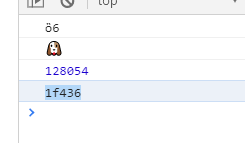
at takes characters based on Subscripts
{ console.log("🐶123".at(0)); }

This chrome browser does not support it. It needs to be compiled into ES5 code
Regular extension (u, y modifier)
There are three ways to create a regular:
{ const pattern1=/^c/g; const pattern2=new RegExp("^c","g"); const pattern3=new RegExp(/^c/g); }
{ const pattern1=/^c/g; const pattern2=new RegExp("^c","g"); const pattern3=new RegExp(/^c/g); console.log("cyy".match(pattern1)); console.log("vyy".match(pattern1)); }

Modifier u unicode
If you do not use the u modifier, if two characters are different when matching, but there is an inclusion condition in unicode, an error will occur
{ console.log(/^\ud83d/.test("\ud83d\udc36"));//true }
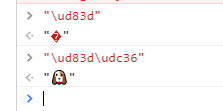
{ console.log(/^\ud83d/.test("\ud83d\udc36"));//true //Use u Modifier, correct judgment unicode console.log(/^\ud83d/u.test("\ud83d\udc36"));//false }

y glue modifier (must match continuously after one match, next to the end of the last match)
{ const r1=/cyy/g; const r2=/cyy/y; const str="cyycyy-cyy"; console.log(r1.exec(str)); console.log(r1.exec(str)); console.log(r1.exec(str)); console.log(r1.exec(str)); console.log("----------------------"); console.log(r2.exec(str)); console.log(r2.exec(str)); console.log(r2.exec(str)); }
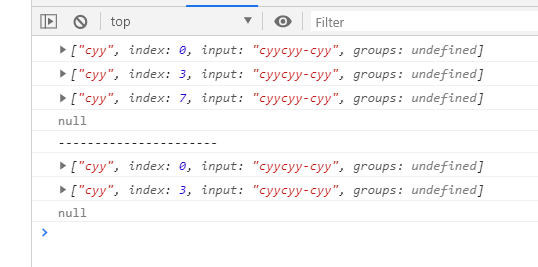
{ let text="\ud83d\udc36"; //.It means to match any character. After adding the first and last restrictions, the string to be matched can only be one character // however'\ud83d\udc36'Is two characters, so cannot match to, return false console.log(/^.$/.test(text));//false //Add to u After that, it will identify text Of unicode Is a character, so it can be matched to console.log(/^.$/u.test(text));//true }

Numerical expansion
New base representation:
{ //0o 0O octonary Octal number system //0b 0B binary Binary system // Previously, 016 was 14 // In order to avoid misunderstanding, the octal is specified as 0 o Start, binary 0 b start console.log(016);//Report errors console.log(0o16);//14 console.log(0b1111);//15 }
New methods and security numbers:
Put parseInt and parseFloat on the Number from the window
{ //Originally hung on window upper console.log(window.parseInt(1.22)); console.log(window.parseFloat(1.22)); //window It can be omitted. console.log(parseInt(1.22)); console.log(parseFloat(1.22)); //ES6 Here we are. Number upper console.log(Number.parseInt(1.22)); console.log(Number.parseFloat(1.22)); }
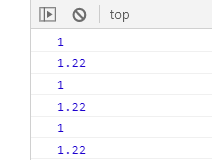
Is isNaN non numeric
{ console.log(Number.isNaN(NaN)); console.log(Number.isNaN(-NaN)); console.log(Number.isNaN("1")); console.log(Number.isNaN(1)); console.log(Number.isNaN(null)); console.log(Number.isNaN(false)); }
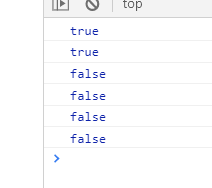
Implement isNaN in its own way
{ console.log(myNaN(NaN)); console.log(myNaN(-NaN)); console.log(myNaN("1")); console.log(myNaN(1)); console.log(myNaN(null)); console.log(myNaN(false)); function myNaN(value){ //NaN Is not equal to itself return value !== value; } }
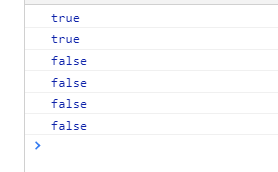
Is isfinish Limited
Max safe integer
Min safe inter
Is isSafeInteger a safe number
{ //Is it limited console.log(Number.isFinite(NaN)); console.log(Number.isFinite(Infinity)); console.log(Number.isFinite(2/0)); console.log(Number.isFinite(1)); console.log(Number.isFinite("123")); console.log(Number.isFinite(true)); console.log(Number.MAX_SAFE_INTEGER);//Maximum safety number console.log(Number.MIN_SAFE_INTEGER);//Minimum safety number console.log(Number.isSafeInteger(Number.MAX_SAFE_INTEGER-1));//Is it a safe number console.log(Number.isSafeInteger(Number.MAX_SAFE_INTEGER+1)); }
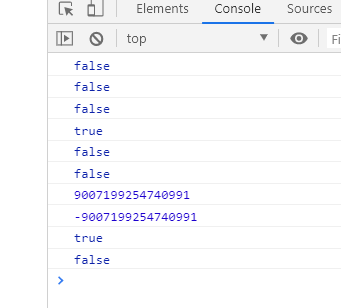
Power operation * *
{ let a=2**10;//2 The 10 time console.log(a);//1024 //Right combination is the default, and 0 times of 10 are calculated first let b=2**10**0; console.log(b);//2 //Change the order of operations with parentheses let c=(2**10)**0; console.log(c);//1 }